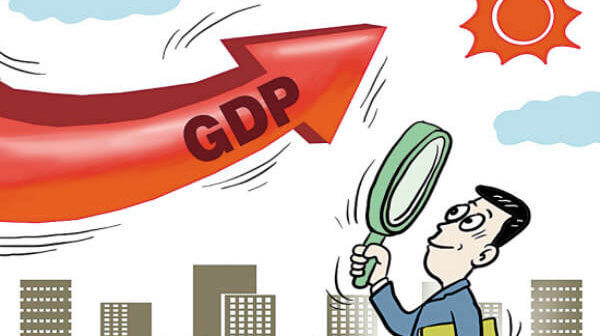Amit Bhanot, Managing Editor, Governance Democracy & Politics Magazine, January Issue
As blamed by many that economic activity in the country was hit by the twin blows of demonetization and implementation-related issues of the goods and services tax (GST), it seems quite likely that Indian economy is expected to expand at its slowest pace in the four years since the Narendra Modi government took office.
Even Government forecast economic growth slowing to 6.5% during current fiscal from 7.1% in the previous year. Though the forecast released by the Central Statistics Office (CSO) assumes that the economy is on a recovery path, economy grew at 6% in the six months ended 30 September, indicating that it will accelerate to 7% in the second half ending 31 March, if the forecast is to come true.
T.C.A. Anant, chief statistician of India, said the lower-than-anticipated nominal GDP growth will lead to “marginal slippage” in the fiscal deficit target for 2017-18—from 3.24% of GDP estimated in the budget to 3.29%—assuming the government borrows, what it budgeted for the year. Since the government has increased its spending through supplementary demands for grants and has communicated that it may borrow Rs 50,000 crore more by 31 March, 2018, the actual fiscal slippage could be more. This may also make it difficult for the finance minister to stick to his fiscal consolidation roadmap of bringing down the fiscal deficit to 3% of GDP by 2018-19.
Interestingly, “GDP growth of 6.5% for 2017-18 implies growth of 7% for the second half. Confirms strong turnaround of the economy,” economic affairs secretary Subhash Chandra Garg tweeted soon after the announcement of the forecast.
Importantly nominal GDP, or gross domestic product at market prices, is expected to grow at 9.5%, slower than the 11.75% growth assumed in the 2017-18 budget. Nominal GDP will be used as the benchmark for most indices such as fiscal deficit in Union Budget 2018, to be presented by finance minister Arun Jaitley on 1 February.
CSO forecast that the agriculture sector will grow at 2.1% in the current financial year, slower than 4.9% in the previous year. Manufacturing is likely to decelerate sharply to grow at 4.6%, compared with 7.9% a year ago, it said.
If experts are to be believed then, while demonetization of high-value banknotes in November 2016 was expected to have disrupted supply chains in the informal economy, the complex filing procedures of GST and delay in refund of input credits may have impacted exporters and small and medium enterprises, forcing companies to pare production and stocks, leading to a decline in manufacturing activity.
Electricity and trade & hotels sectors are the only ones that are expected to grow at a faster pace in FY18 compared with the previous financial year, at 7.5% and 8.7% respectively. On the other hand GVA (gross value added) estimate of 6.1% by CSO is much lower than the 6.7% growth projected by Reserve Bank of India in its latest bi-monthly monetary policy review on 6 December.
In terms of private consumption, slowdown is quite visible as growth in private consumption is expected to slow to 6.3% in FY18, whild investment demand growth is estimated to quicken to 4.5% during the same year. Just to add to that public expenditure, which was the driver of economic growth in the previous year, is likely to slow to 9.4% against 11.3% a year ago, which could add to the government worries.
All these data clearly suggest that Indian economy is not in such a good shape and needs an urgent focus from the government. Interestingly estimated 6.5% GDP growth is also based on the assumption of buoyant growth in the indirect taxes in the budget, but after implementation of GST, that expected growth is not that easy to achieve. Experts feel that if there is any deviation happens on indirect taxes front then GDP growth could further slow down to around 6.3%.
On the other hand favourable base effect could be a silverline in the dark clouds, as data is available to estimate is of limited period and it may not clearly depict the pickup in the economic activity in various sector during the later months of FY18. All this may push GDP growth to around 6.5%, if not further.
But even if we take 6.5% growth as constant, there is a huge challenge in hand before FM Shri Arun Jaitley and he has to go all out in the open to address that. First and foremost challenge before him is to anyhow improve the consumption pattern of the country, as that activity has been badly hit by demontisation first and then failure in the employment generation capacity of the country, especially in manufacturing and agriculture.
I think if consumption pattern improves then it will automatically solve majority of problems related to economy, as people currently are postponing their spending in anticipation of further slowdown and bleak period ahead. In this sops like hiking the income tax slabs and giving more incentives to common man in the upcoming budget would be of great help and is also anticipated.
In my view if demand side of the economy improves during next few quarters, then private investment in terms of capital expenditure would surely start and further push economy further. So in the current situation government should put measures to increase tax base and agenda of filling exchequer on the back seat and resort to steps to push the demand and Indian Economy would automatically come on track. After all we know the great strength of Indian Domestic Demand and surely we believe in India’s Story.





